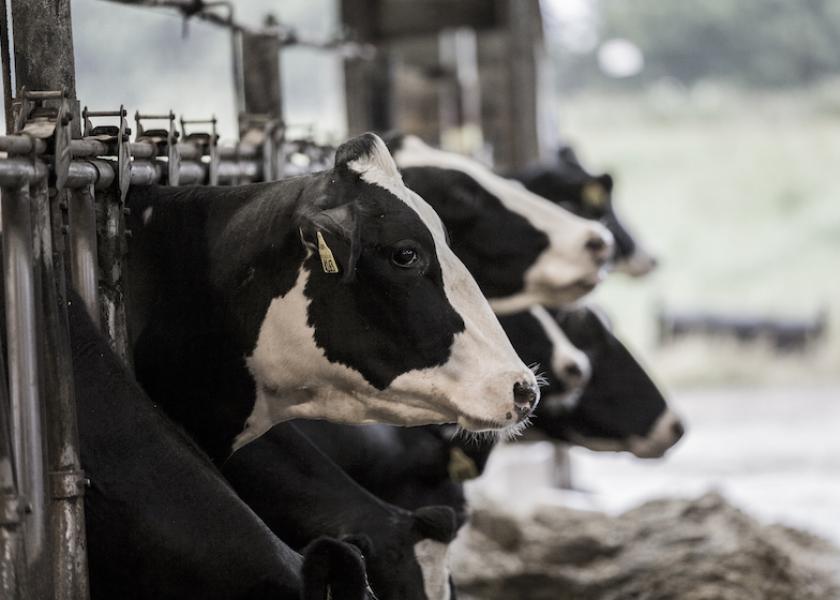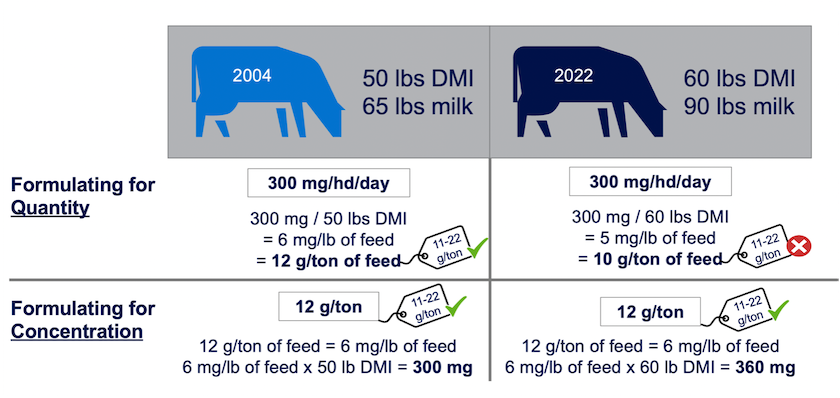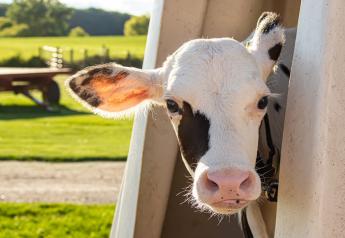A Tale of Two Cows: Dosing the Animal vs. the Feed

Flashback to 20 years ago. It was the best of times; it was the worst of times: The cows ate less but required more feed per pound of milk. There’s no doubt that today’s cows are exponentially more efficient than even 20 years ago. The dairy industry is making more milk per pound of feed while emitting about 45% fewer greenhouse gasses per pound of milk since 1961.1
Today’s cows have evolved quite a bit, particularly in terms of size, dry matter intake (DMI) and milk production. As cows get larger, produce more milk and increase their feed intake, how we think about feed ingredient levels may need to change depending on many factors. Should you be thinking about your feed ingredients in terms of quantity delivered to the cow or as concentration in the feed? A great place to start is with the mode of action.
Where does the feed ingredient work?
The gastrointestinal tract is essentially a tube running from the mouth all the way to the back end of the cow. Everything that enters this tube (feed, water, etc.) is still technically outside the cow’s body until it crosses the gut and is absorbed. The moment it’s absorbed across the gut, it becomes part of the cow. Where a feed ingredient works, whether in the cow (post-absorptive) or in the rumen contents (pre-absorptive), makes a huge difference in how we need to think about the amount fed.
- Post-absorptive: If the feed ingredient is utilized by the animal
If the cow herself is utilizing the ingredient post-absorptively (after it crosses the gut and into circulation), it’s most logical to think about the quantity of whatever feed ingredient we’re trying to get into her system. For example, if a cow in 2004 is milking 65 lbs per day, she requires around 1,160 mg of dietary zinc per day.
Does a cow in 2023 require more zinc? Yes. However, she’s also eating a lot more zinc, so the concentration in the feed doesn’t necessarily change in proportion to her zinc requirement. It’s more accurate to pay attention to the quantity of her requirements first, then back into the math that gives us the dietary concentration to get to the needed quantity. - Pre-absorptive: If the feed ingredient is acting on feed or microbes in the rumen
When dosing the feed, it makes sense to think about the ingredient in terms of concentration. Rumen modifiers work in that large black box we call the rumen, and the bigger and fuller the box gets, the more ingredient we may need to have an effect. A great analogy involves a beloved childhood beverage—the nostalgic and refreshing glass of lemonade. It takes about one lemon to make one cup of lemonade. If I need to make 10 cups of lemonade, I would use 10 lemons—not one. The goal isn’t to dose with a particular number of lemons but to have an effectively tasty lemonade with a 1:1 ratio of lemon per cup of water.
Trusted by generations
A great real-world example of a rumen modifier is Rumensin®. Rumensin shifts rumen bacterial populations to produce a higher proportion of propionate. This reduces the amount of energy wasted as carbon dioxide and methane, allowing cows to get more energy from the ration.2
The label for Rumensin indicates 11 to 22 g/ton of feed (dry matter basis). Let’s go back to the tale of two cows. Back when Rumensin was first approved for dairy cows in 2004, it was common to feed 300 mg/hd/day. At 50 lbs DMI (a common average intake in 2004), this equals around 12 g/ton and falls within the label requirement of 11 to 22 g/ton. Fast-forward to 2023, where 60 lbs DMI is a common average.
If you keep formulating the diet to provide 300 mg/hd/day of Rumensin, the concentration has now been diluted to 83% of its original value at 10 g/ton of feed. Rumensin is less effective at lower concentrations, and its benefits to milk production efficiency could be underutilized.
Note: The below data represents assumed common averages.

The bottom line
There’s significant potential in how nutritionists and producers can rethink quantity versus concentration dosing of feed additives, especially when the mode of action is in the rumen. Keep up to date with your cows. Take advantage of additives that can offer better milk production efficiency. Don’t make bad lemonade. Speak with a nutritionist, Elanco Animal Health consultant or extension representative to assess and optimize your operation’s feed strategies.
1Food and Agriculture Organization of the United Nations. Emissions intensities. Available at: https://www.fao.org/faostat/en/#data/EI. Accessed: February 13, 2023.
2Appuhamy RN, Strathe AB, Jayasundara S, et al. Anti-methanogenic effects of monensin in dairy and beef cattle: A meta-analysis. J Dairy Sci. 2013;96(8):5161-73. https://doi.org/10.3168/jds.2012-5923. Accessed: February 13, 2023.
The label contains complete use information, including cautions and warnings. Always read, understand and follow the label and use directions.
For Rumensin:
CAUTION: Consumption by unapproved species or feeding undiluted may be toxic or fatal. Do not feed to veal calves.
Feeding Directions
Dairy cows: For increased milk production efficiency (production of marketable solids-corrected milk per unit of feed intake):
Total Mixed Rations (“complete feed”): Feed continuously to dry and lactating dairy cows a total mixed ration (“complete feed”) containing 11 to 22 g/ton monensin on a 100% DM basis.
Component Feeding Systems (including top dress): Feed continuously to dry and lactating cows a Type C medicated feed containing 11 to 400 g/ton monensin. The Type C medicated feed must be fed in a minimum of 1.0 lb of feed/cow/day to provide 185 to 660 mg/hd/day monensin to lactating cows or 115 to 410 mg/hd/day monensin to dry cows. This provides cows with similar amounts of monensin they would receive by consuming total mixed rations containing 11 to 22 g/ton monensin on a 100% DM basis.
Rumensin, Elanco and the diagonal bar logo are trademarks of Elanco or its affiliates.
© 2023 Elanco or its affiliates. PM-US-23-0048







